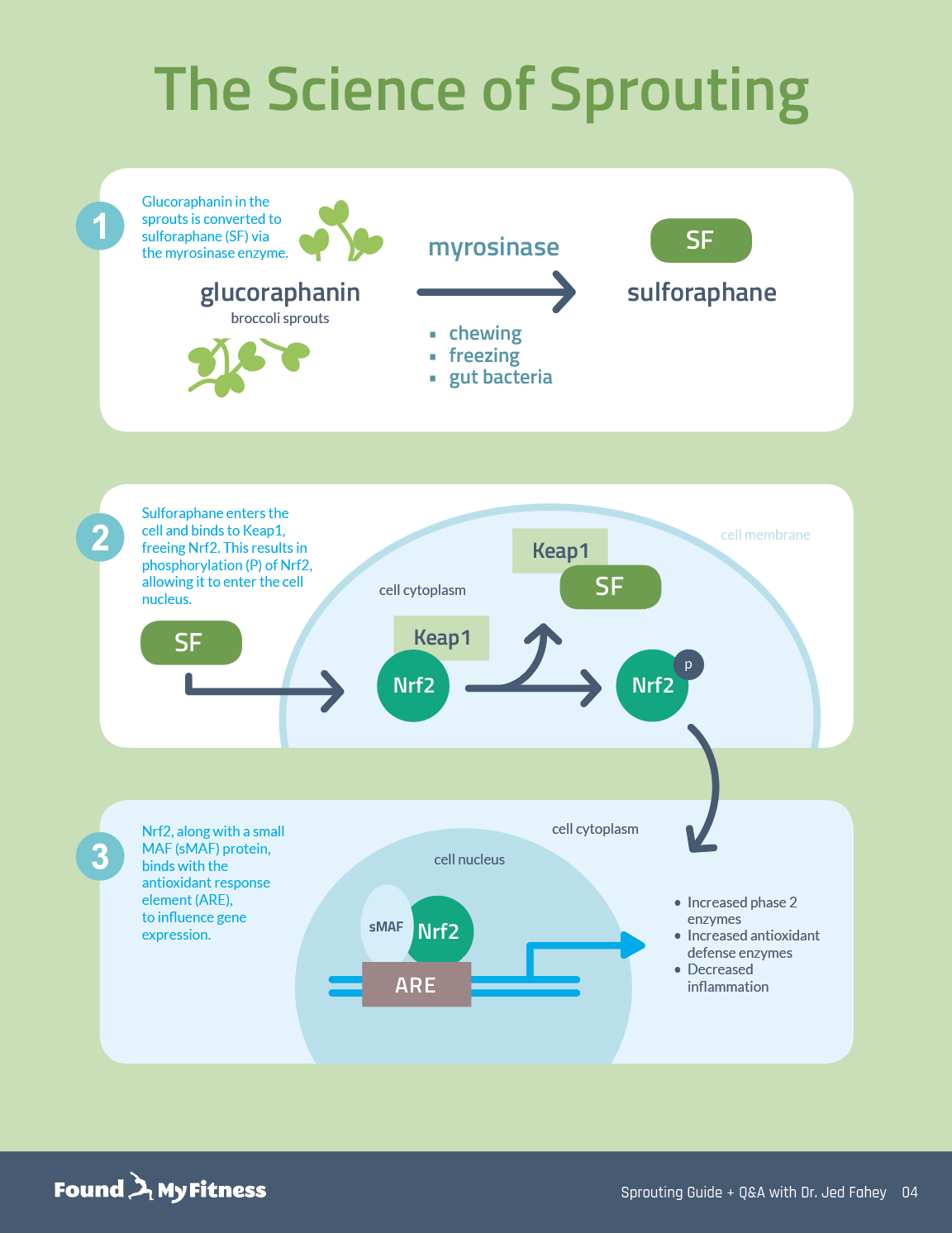Sulforaphane promotes detoxification of heavy metals | Jed Fahey
Enter your email to get our 15-page guide to sprouting broccoli and learn about the science of chemoprotective compount sulforaphane.
Broccoli sprouts are concentrated sources of sulforaphane, a type of isothiocyanate. Damaging broccoli sprouts – when chewing, chopping, or freezing – triggers an enzymatic reaction in the tiny plants that produces sulforaphane.

Get the full length version of this episode as a podcast.
This episode will make a great companion for a long drive.
Glutathione is a powerful antioxidant that facilitates the body's excretion of a wide range of toxic substances, including pesticides, aflatoxin, and air pollutants. It binds with many of these toxins and forms mercapturic acids, which can be excreted and measured in urine. Sulforaphane promotes the production of glutathione by up-regulating enzymes necessary for its synthesis – and re-synthesis – making more glutathione available to the body's cells. And once glutathione is sacrificed and oxidized, it remakes it. In this clip, Dr. Jed Fahey describes how sulforaphane facilitates the detoxication of heavy metals by increasing glutathione synthesis.
[Dr. Patrick]: Cool. There's someone asking in the chat, Christa Bluff, "Is there any research around toxic metals and increased detoxification with sulforaphane?" So we mentioned some of these carcinogens, but has there been any evidence on metals?
[Dr. Fahey]: There's been some. I'm not... I mean I'd have to go and dig those papers out for you, Christa, because I'm not intimately familiar with them and we haven't...we didn't do them. But since you mention... So the answer is yes, and I'll try to find you those references. But that brings up the question of pesticides and other toxins. You know, we've talked about air pollutants and we've talked about a lot of disease states and protection against cancer, and so on and so forth. But others, a number of years ago especially, have looked at things like paraquat toxicity. And there are a number of other pesticides, I can't at the moment remember which ones they are.
[Dr. Patrick]: Rotenone?
[Dr. Fahey]: Rotenone I think it one, yeah. People have looked at the ability of sulforaphane to detoxify them or to enhance the elimination of them. So, and certainly we've done...my colleague Tom Kensler and that whole team has...I mean they started out in these Chinese studies looking at aflatoxin. Which is different than metals and it's different than pesticides, but it is a potent toxin and carcinogen that is actually present in peanuts and corn in the part of China where we were working. And clearly, and this is sort of a model for the metal and the pesticide detoxication, clearly aflatoxin is converted to a derivative bound to compounds which allow it to be more readily excreted in the urine.
So this is something that is...this is what we call detoxication, or detoxification. And indeed it's pretty widespread. Because... So this is probably involved in a subsequent question, but a lot of this is because of the upregulation of glutathione. And glutathione is the body's most predominant detoxification mechanism. It's present at very high levels in things like the macula of the eye, the back of the eye, the retina. And it is a tripeptide, meaning it's made up of only three amino acids, and it is a very potent antioxidant that is endogenous, it's part of your body. But what sulforaphane does is it cranks up the enzymes that are responsible for synthesizing, or resynthesizing, glutathione. And so it makes more glutathione available. And once glutathione is sacrificed and oxidized, it remakes it.
And so that's... I mean it's a long way...all my answers are long ways of answering simple questions, I guess, but that's a way of saying that's sort of where sulforaphane comes into that detoxification pathway. One of many ways, but it's probably one of the most important ways.
[Dr. Patrick]: Yeah, we are going to talk a little bit more about glutathione in another question, but I just want to ask you is that... Specifically, you know, there has been clinical studies that it increases glutathione in the plasma and in the brain. I don't remember how far out those clinical studies went. But you...as you were saying previously with the air pollution studies that you had been collaborating with your colleagues in China, the activation of the NRF2 system did not stop as long as you were continually taking the broccoli sprout extract, right? So the glutathione levels would keep going up. If you were... It's not something that just goes away over time.
[Dr. Fahey]: Right. Well, they won't keep going up, you know, forever. I mean they'll keep being replenished.
[Dr. Patrick]: They'll continue... Right, exactly.
[Dr. Fahey]: Yeah, yeah, yeah. So if you insult your body with a toxin that is detoxified by glutathione, yes, there will be a dip in glutathione levels. What actually happens is the reduced form of glutathione turns into the oxidized form, and then the reduced form glutathione is regenerated. So that cycling happens more efficiently and indeed the levels, overall levels, of glutathione are somewhat elevated.
A family of carcinogenic toxins produced by certain fungi endemic to areas with hot and humid climates. Aflatoxins are commonly found in agricultural crops such as maize (corn), peanuts, cottonseed, and tree nuts. In people who are infected with hepatitis B, aflatoxin markedly increases the risk for liver cancer.[1]
- ^ Groopman, John; Kensler, Thomas W.; Wild, Christopher P. (2008). Protective Interventions To Prevent Aflatoxin-Induced Carcinogenesis In Developing Countries Annual Review Of Public Health 29, 1.
A molecule that inhibits oxidative damage to DNA, proteins, and lipids in cells. Oxidative damage plays a role in the aging process, cancer, and neurodegeneration. Many vitamins and plant-based compounds are antioxidants.
Any of a group of complex proteins or conjugated proteins that are produced by living cells and act as catalyst in specific biochemical reactions.
An antioxidant compound produced by the body’s cells. Glutathione helps prevent damage from oxidative stress caused by the production of reactive oxygen species.
An essential mineral present in many foods. Iron participates in many physiological functions and is a critical component of hemoglobin. Iron deficiency can cause anemia, fatigue, shortness of breath, and heart arrhythmias.
A chemical that causes Parkinson's disease-like symptoms. MPTP undergoes enzymatic modification in the brain to form MPP+, a neurotoxic compound that interrupts the electron transport system of dopaminergic neurons. MPTP is chemically related to rotenone and paraquat, pesticides that can produce parkinsonian features in animals.
A protein typically present in the cytoplasm of mammalian cells. Nrf2 can relocate to the nucleus where it regulates the expression of hundreds of antioxidant and stress response proteins that protect against oxidative damage triggered by injury and inflammation. One of the most well-known naturally-occurring inducers of Nrf2 is sulforaphane, a compound derived from cruciferous vegetables such as broccoli.
Highly reactive molecules that have the ability to oxidize other molecules and cause them to lose electrons. Common oxidants are oxygen, hydrogen peroxide, and superoxide anion.
A toxic chemical widely used to kill weeds on land and in aquatic settings. Paraquat is a type of dipyridylium herbicide. It is highly toxic to humans and other mammals due to its capacity to form free radicals, promoting oxidative stress and mitochondrial dysfunction. Exposure to paraquat can cause lung scarring and induce kidney, heart, and liver failure. Evidence indicates that paraquat exposure increases a person's risk of developing Parkinson's disease.[1]
- ^ Sandler, D P; Kasten, Meike; Hoppin, J. A; Kamel, Freya; Goldman, Sam; Tanner, Caroline M., et al. (2011). Rotenone, Paraquat, And Parkinson’s Disease Environmental Health Perspectives 119, 6.
A naturally occurring pesticide and insecticide derived from a variety of plant species, including those of the Fabaceae family. Rotenone interrupts complex I of the electron transport chain, eliciting mitochondrial dysfunction and nigrostriatal pathway cell loss. Acute exposure to rotenone in humans induces nausea, vomiting, tremors, lethargy, convulsions, and depression. Chronic exposure elicits dopaminergic neuron degeneration and subsequent symptoms of Parkinson's disease.
An isothiocyanate compound derived from cruciferous vegetables such as broccoli, cauliflower, and mustard. Sulforaphane is produced when the plant is damaged when attacked by insects or eaten by humans. It activates cytoprotective mechanisms within cells in a hormetic-type response. Sulforaphane has demonstrated beneficial effects against several chronic health conditions, including autism, cancer, cardiovascular disease, diabetes, and others.
Hear new content from Rhonda on The Aliquot, our member's only podcast

Listen in on our regularly curated interview segments called "Aliquots" released every week on our premium podcast The Aliquot. Aliquots come in two flavors: features and mashups.
- Hours of deep dive on topics like fasting, sauna, child development surfaced from our enormous collection of members-only Q&A episodes.
- Important conversational highlights from our interviews with extra commentary and value. Short but salient.





































































